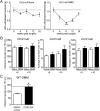CCR2 chemokine receptor signaling mediates pain in experimental osteoarthritis
- PMID: 23185004
- PMCID: PMC3528555
- DOI: 10.1073/pnas.1209294110
CCR2 chemokine receptor signaling mediates pain in experimental osteoarthritis
Abstract
Osteoarthritis is one of the leading causes of chronic pain, but almost nothing is known about the mechanisms and molecules that mediate osteoarthritis-associated joint pain. Consequently, treatment options remain inadequate and joint replacement is often inevitable. Here, we use a surgical mouse model that captures the long-term progression of knee osteoarthritis to longitudinally assess pain-related behaviors and concomitant changes in the innervating dorsal root ganglia (DRG). We demonstrate that monocyte chemoattractant protein (MCP)-1 (CCL2) and its high-affinity receptor, chemokine (C-C motif) receptor 2 (CCR2), are central to the development of pain associated with knee osteoarthritis. After destabilization of the medial meniscus, mice developed early-onset secondary mechanical allodynia that was maintained for 16 wk. MCP-1 and CCR2 mRNA, protein, and signaling activity were temporarily up-regulated in the innervating DRG at 8 wk after surgery. This result correlated with the presentation of movement-provoked pain behaviors, which were maintained up to 16 wk. Mice that lack Ccr2 also developed mechanical allodynia, but this started to resolve from 8 wk onwards. Despite severe allodynia and structural knee joint damage equal to wild-type mice, Ccr2-null mice did not develop movement-provoked pain behaviors at 8 wk. In wild-type mice, macrophages infiltrated the DRG by 8 wk and this was maintained through 16 wk after surgery. In contrast, macrophage infiltration was not observed in Ccr2-null mice. These observations suggest a key role for the MCP-1/CCR2 pathway in establishing osteoarthritis pain.
Conflict of interest statement
The authors declare no conflict of interest.
Figures




Similar articles
-
The role of intra-articular neuronal CCR2 receptors in knee joint pain associated with experimental osteoarthritis in mice.Arthritis Res Ther. 2021 Apr 7;23(1):103. doi: 10.1186/s13075-021-02486-y. Arthritis Res Ther. 2021. PMID: 33827672 Free PMC article.
-
Contribution of chemokine CCL2/CCR2 signaling in the dorsal root ganglion and spinal cord to the maintenance of neuropathic pain in a rat model of lumbar disc herniation.J Pain. 2014 May;15(5):516-26. doi: 10.1016/j.jpain.2014.01.492. Epub 2014 Jan 23. J Pain. 2014. PMID: 24462503
-
CCL2/CCR2, but not CCL5/CCR5, mediates monocyte recruitment, inflammation and cartilage destruction in osteoarthritis.Ann Rheum Dis. 2017 May;76(5):914-922. doi: 10.1136/annrheumdis-2016-210426. Epub 2016 Dec 13. Ann Rheum Dis. 2017. PMID: 27965260 Free PMC article.
-
Chemokine signaling and the management of neuropathic pain.Mol Interv. 2009 Aug;9(4):188-95. doi: 10.1124/mi.9.4.7. Mol Interv. 2009. PMID: 19720751 Free PMC article. Review.
-
Inflammation, endoplasmic reticulum stress, autophagy, and the monocyte chemoattractant protein-1/CCR2 pathway.Circ Res. 2012 Jan 6;110(1):174-89. doi: 10.1161/CIRCRESAHA.111.243212. Circ Res. 2012. PMID: 22223213 Free PMC article. Review.
Cited by
-
Analgesic dorsal root ganglion field stimulation blocks both afferent and efferent spontaneous activity in sensory neurons of rats with monosodium iodoacetate-induced osteoarthritis.Osteoarthritis Cartilage. 2022 Nov;30(11):1468-1481. doi: 10.1016/j.joca.2022.08.008. Epub 2022 Aug 24. Osteoarthritis Cartilage. 2022. PMID: 36030058 Free PMC article.
-
Curcumin slows osteoarthritis progression and relieves osteoarthritis-associated pain symptoms in a post-traumatic osteoarthritis mouse model.Arthritis Res Ther. 2016 Jun 3;18(1):128. doi: 10.1186/s13075-016-1025-y. Arthritis Res Ther. 2016. PMID: 27260322 Free PMC article.
-
The Role of Peripheral Nociceptive Neurons in the Pathophysiology of Osteoarthritis Pain.Curr Osteoporos Rep. 2015 Oct;13(5):318-26. doi: 10.1007/s11914-015-0280-1. Curr Osteoporos Rep. 2015. PMID: 26233284 Free PMC article. Review.
-
Inflammation in osteoarthritis: the latest progress and ongoing challenges.Curr Opin Rheumatol. 2023 Mar 1;35(2):128-134. doi: 10.1097/BOR.0000000000000923. Epub 2022 Dec 22. Curr Opin Rheumatol. 2023. PMID: 36695054 Free PMC article. Review.
-
Understanding the Molecular Mechanisms Underlying the Pathogenesis of Arthritis Pain Using Animal Models.Int J Mol Sci. 2020 Jan 14;21(2):533. doi: 10.3390/ijms21020533. Int J Mol Sci. 2020. PMID: 31947680 Free PMC article. Review.
References
-
- Dieppe PA, Lohmander LS. Pathogenesis and management of pain in osteoarthritis. Lancet. 2005;365(9463):965–973. - PubMed
-
- Kotlarz H, Gunnarsson CL, Fang H, Rizzo JA. Insurer and out-of-pocket costs of osteoarthritis in the US: Evidence from national survey data. Arthritis Rheum. 2009;60(12):3546–3553. - PubMed
Publication types
MeSH terms
Substances
Grants and funding
LinkOut - more resources
Full Text Sources
Other Literature Sources
Medical
Molecular Biology Databases
Miscellaneous

